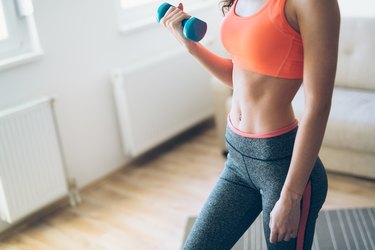
People don't talk too much about the brachialis muscle. The overlooked muscle peeks out on the front of the arm just above the elbow. However, the brachialis muscle is essential in sports like climbing, swimming and gymnastics, and doing brachialis exercises will make other arm muscles appear more prominent.
Brachialis vs. Biceps
Video of the Day
The brachialis muscle runs from the humerus — the long bone in the upper arm — to the ulna, the thin bone on the pinky side of the forearm. The muscle crosses the front of the elbow and provides the primary flexion for the joint.
Video of the Day
Although the biceps run over the top of most of the brachialis, it's not the heavy lifter for the elbow joint. The brachialis is actually a much stronger muscle than your biceps.
That means that when you're pumping away at those biceps curls, it's your brachialis that's actually doing most of the work. However, regularly including brachialis exercises in your exercise regime will help your bicep muscles look more prominent when you flex.
Injury to your brachialis can cause it to press on one of the primary nerves that passes through it, creating a pins-and-needles sensation or pain that radiates from elbow to thumb. Nerve entrapment can also cause symptoms of weakness without much in the way of sensory symptoms.
Brachialis Exercises: Lift Some Weights
The brachialis workout for the muscle includes doing dumbbell/barbell biceps curls, hammer curls, and preacher curls, as recommended by NASM.org. But don't just do brachialis exercises for this single muscle, or you'll risk injuring the less-developed muscles. Combine upper and lower arm exercises that use muscles that connect to each of the three arm joints — wrist, elbow and shoulder. Keeping arms evenly developed will give you an all-over tone to your guns and help you in daily tasks requiring arm strength.
Biceps curl: Keep your wrist straight and rigid and don't swing your arm as you pull a dumbbell or weight from your side to your shoulder by bending your elbow toward your chest. Keep your palms facing away from you, and your elbow tucked into your side as you slowly raise and lower the weight during the biceps curl in your brachialis workout.
Read more: The 20 Best Body-Weight Exercises
Barbell biceps curl: Hold a barbell with both hands with palms facing outward. Keep your spine erect as you lift the bar toward your chest.
Hammer curl: Hold a dumbbell in each hand with your arms at your sides and your palms facing one another. Keeping your shoulder blades retracted, raise and lower one dumbbell toward your chest. Repeat the same movement on the opposite side during your brachialis workout.
Tip
Don't cheat! It's easy to use a rocking motion in your shoulders to get the momentum going when doing these exercises. To minimize the tendency, try standing with your back pressed against a wall when doing the movements.
Preacher curl#: Use a preacher bench or incline bench at the gym to position your arms flat along an incline with your shoulder immobilized at the end nearest you to isolate the brachialis and biceps muscles.
Cable biceps curl: Stand with your arm extended, holding the handle of a cable machine that is adjusted to shoulder level. Keep your arm straight out in front of you and slowly bring your hand back toward your shoulder. Maintain slow movement against the resistance as you return your arm to the extended position.
Brachialis Workout: Take a Swim
The brachialis muscles come into play with each swimming stroke as the elbows bend, giving you the perfect opportunity to strengthen them in a relatively weightless environment. This can be especially helpful when you're trying to recover from upper-body injuries that can limit your time with dry land training.
The brachialis comes into play during the initial catch phase of each stroke — freestyle, backstroke, butterfly and breaststroke — as the elbow progresses from full extension to optimal flexion.
In freestyle, the primary load on the brachialis comes during the first 30 degrees of elbow flexion. The range of brachialis effort in the butterfly is slightly more, about 40 degrees. In backstroke, the elbow goes from full extension to as much as 90 degrees of flexion during the catch and propulsive phase of the stroke.
In breaststroke, the brachialis only comes into play during the second half of the pull phase, as the elbow comes into the side of the body, before the arms thrust back to full extension. The first half of the pull phase primarily uses the triceps brachii.
The brachialis muscle also comes into play during tumble turns, as you push forcefully against the water as you flex your elbow to flip yourself over. Performing forceful flips down the pool will help strengthen your brachialis muscle and assist you in developing quicker turns.
Read more: The Ultimate Workout for Sexy, Sculpted Arms
- Lumen: "Muscles of the Upper Arm"
- Brookbush Institute: "Arm Muscles"
- NASM.org: "9 Arm Exercises for Definition and Strength"
- Northeast Texas Community College: Biceps Exercises
- American Swimming Coaches Association: Swimming Anatomy Parts 1 and 2
- YouBooks: Swimming Anatomy by Ian McLeod
- Study.com: "Brachialis Muscle Function, Location and Nerve Supply"
- ScienceDirect: Brachialis Muscle
- Mayo Clinic: Biceps Curl With Dumbbell
- Washington State University: Bosu Hammer Curls
- Criticalbench.com: Reverse Curl to Get Bigger Arms